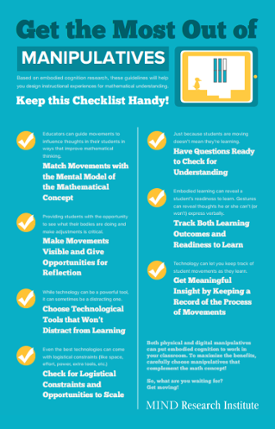
Try to think way back to when you first stopped using your fingers to count. (No, seriously. Take a second and try. Can you get back there?)
Was it hard to stop your fingers from twitching? Did you find yourself imagining your fingers or another object in your head instead?
Research on embodied cognition explores how physical gestures and manipulatives can benefit learning by strengthening encoding, reducing cognitive load, and inspiring the use of other strategies.
Manipulatives literally allow students to play with and explore math concepts, building the neural connections that become foundational to symbolic math. With manipulatives, students have the chance to figure things out on their own.
But, our fingers (and other physical manipulatives) have limitations.
Eventually, we need to count above 10 and must discover other strategies. Luckily, we can leverage technology in many ways during the learning process. From technology's ability to provide an almost limitless number of digital fingers, to providing immediate informative feedback, educators can use technology to design embodied experiences that deliver deeper mathematical understanding.
Based on a recent research paper authored by MIND colleagues Cathy Tran*, Martin Buschkuehl and Brandon Smith, on the link between embodied cognition and math, here are some best practices for using digital manipulatives in your instruction.
We can guide movements to influence thoughts in ways that improve mathematical cognition by being sure to cue the right gestures for the mathematical concept. For example:
Provide real-time metrics that allow learners to observe what their body is doing and compare it to the important features of the learning objective. Immediate informative feedback is a crucial component of the perception-action cycle, showing students the effects of their action. For example, use or incorporate:
Technology is just a tool. Like other tools in the classroom, it has the potential to be distracting and overwhelming. Pay attention to the visual and auditory effects. Are they enhancing learning? Does it provide feedback that students can use to adjust their approach? Research suggests that if the technology is too noisy with details, it will take away from the learning content.
If you’ve ever had to set up thirty sets of Cuisenaire rods for a particular activity, you know how challenging it can be to facilitate instruction using physical manipulatives for an entire classroom. Digital manipulatives, for the most part, are easier to scale. But even great technology has logistical limitations. Ask yourself:
Just because we see the connection between the movement and the math concept doesn’t mean our students will. Have some questions ready to check for understanding.
Research shows that embodied learning can provide indicators of students’ readiness to learn. Gestures can reveal thoughts that learners cannot express verbally. Watch for when students’ words don’t match their gestures. This may indicate that their brain is starting to make the right connections.
Technology often provides the opportunity for educators to keep track of a student's movements during the learning process. Some software programs allow educators to playback and review student actions, allowing the student to actually share their thought processes and strategies. Most software will collect data over time -- individually and/or in aggregate -- so educators (and students!) can track progress.
Try this:
Ask students to use their bodies to represent multiplication without physically indicating the operation. This could open a window into their thinking in a way that paper and pencil cannot. For example, a student may start small and move into a posture to get larger as a way to embody “multiplication makes things bigger.”
And this:
Use a camera phone to record several different movements, and ask students to identify which ones embody multiplication. This could provide insight into student cognition that can only be gained when technology and movement collide.

Looking to share these best practices with other educators? Download it in the Digital Manipulatives Toolkit!
*Cathy Tran is now at Osmo.

Calli Wright was the Marketing Manager at MIND Research Institute. She loves playing and designing board games, which she often talks about on twitter @CalliWrights.
Comment